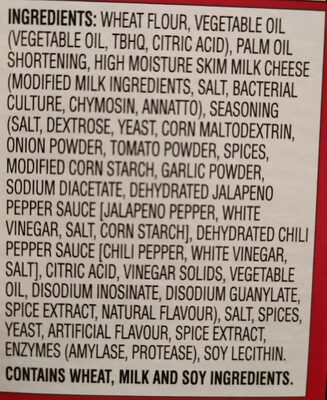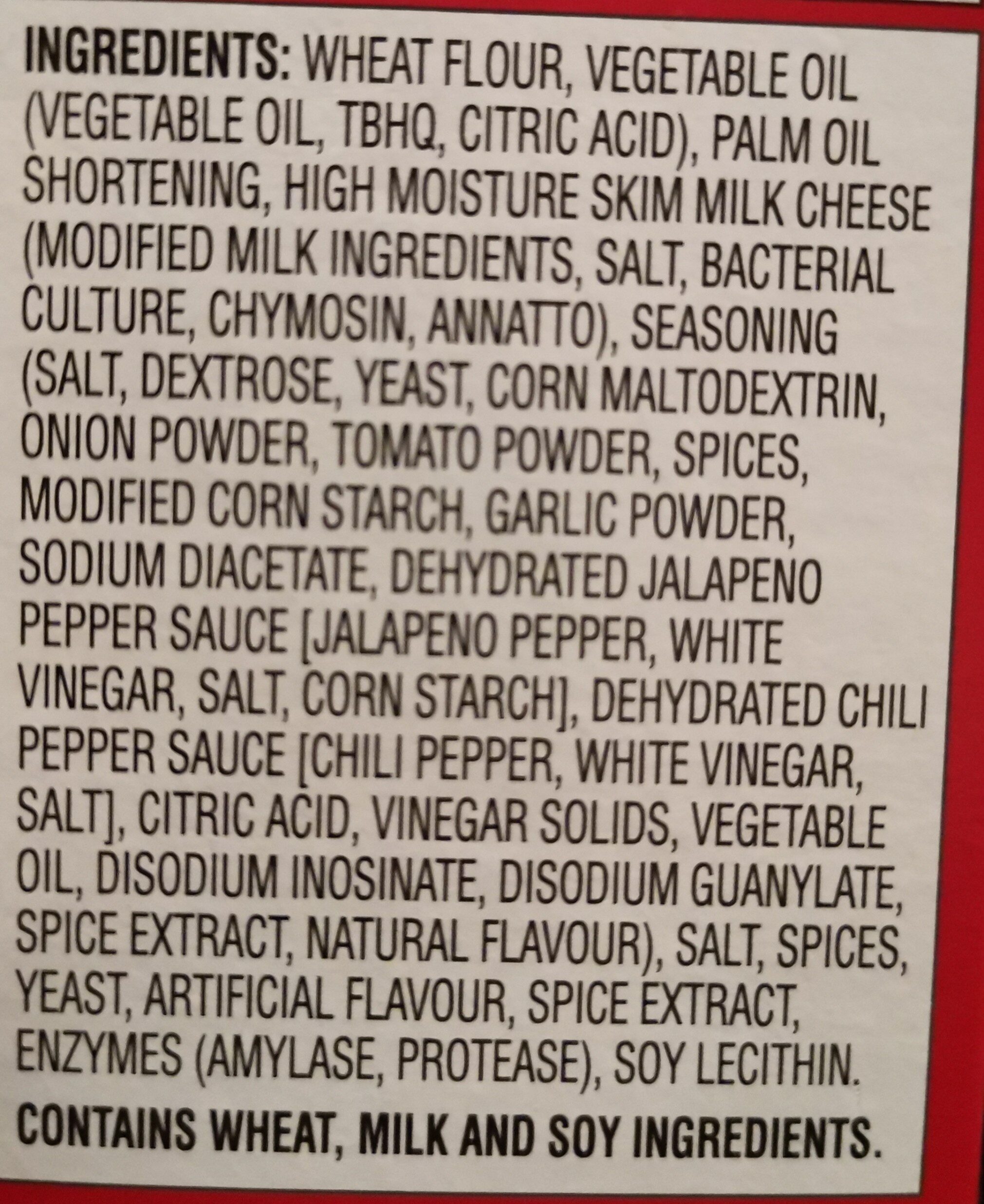Help us make food transparency the norm!
As a non-profit organization, we depend on your donations to continue informing consumers around the world about what they eat.
The food revolution starts with you!
CHEEZ IT Hot & Spicy
CHEEZ IT Hot & Spicy
This product page is not complete. You can help to complete it by editing it and adding more data from the photos we have, or by taking more photos using the app for Android or iPhone/iPad. Thank you!
×
Barcode: 0064100131651 (EAN / EAN-13) 064100131651 (UPC / UPC-A)
Categories: Snacks, Salty snacks, Appetizers
Countries where sold: Canada
Matching with your preferences
Health
Ingredients
-
49 ingredients
wheat flour, vegetable oil (vegetable oil, tbhq, citric acid), palm oil shortening, high moisture skim milk cheese (modified milk ingredients, salt, bacterial culture, chymosin, annatto), seasoning (salt, dextrose, yeast, corn maltodextrin, onion powder, tomato powder, spices, modified corn starch, garlic powder, sodium diacetate, dehydrated jalapeno pepper sauce [jalapeno pepper, white vinegar, salt, corn starch], dehydrated chili pepper sauce [chili pepper, white vinegar, salt], citric acid, vinegar solids, vegetable oil, disodium inosinate, disodium guanylate, spice extract, natural flavour), salt, spices, yeast, artificial flavour, spice extract, enzymes (amylase, protease), soy lecithin. contains wheat, milk and soy ingredients.Allergens: Gluten, Milk, Soybeans
Food processing
-
Ultra processed foods
Elements that indicate the product is in the 4 - Ultra processed food and drink products group:
- Additive: E160b - Annatto
- Additive: E322 - Lecithins
- Additive: E627 - Disodium guanylate
- Additive: E631 - Disodium inosinate
- Ingredient: Dextrose
- Ingredient: Flavouring
- Ingredient: Glucose
- Ingredient: Maltodextrin
Food products are classified into 4 groups according to their degree of processing:
- Unprocessed or minimally processed foods
- Processed culinary ingredients
- Processed foods
- Ultra processed foods
The determination of the group is based on the category of the product and on the ingredients it contains.
Additives
-
E1100 - Alpha-Amylase
Amylase: An amylase -- is an enzyme that catalyses the hydrolysis of starch into sugars. Amylase is present in the saliva of humans and some other mammals, where it begins the chemical process of digestion. Foods that contain large amounts of starch but little sugar, such as rice and potatoes, may acquire a slightly sweet taste as they are chewed because amylase degrades some of their starch into sugar. The pancreas and salivary gland make amylase -alpha amylase- to hydrolyse dietary starch into disaccharides and trisaccharides which are converted by other enzymes to glucose to supply the body with energy. Plants and some bacteria also produce amylase. As diastase, amylase was the first enzyme to be discovered and isolated -by Anselme Payen in 1833-. Specific amylase proteins are designated by different Greek letters. All amylases are glycoside hydrolases and act on α-1‚4-glycosidic bonds.Source: Wikipedia
-
E1101 - Protease
Protease: A protease -also called a peptidase or proteinase- is an enzyme that performs proteolysis: protein catabolism by hydrolysis of peptide bonds. Proteases have evolved multiple times, and different classes of protease can perform the same reaction by completely different catalytic mechanisms. Proteases can be found in Animalia, Plantae, Fungi, Bacteria, Archaea and viruses.Source: Wikipedia
-
E262 - Sodium acetates
Sodium acetate: Sodium acetate, CH3COONa, also abbreviated NaOAc, is the sodium salt of acetic acid. This colorless deliquescent salt has a wide range of uses.Source: Wikipedia
-
E262ii - Sodium diacetate
Sodium acetate: Sodium acetate, CH3COONa, also abbreviated NaOAc, is the sodium salt of acetic acid. This colorless deliquescent salt has a wide range of uses.Source: Wikipedia
-
E319 - Tertiary-butylhydroquinone (tbhq)
Tert-Butylhydroquinone: tert-Butylhydroquinone -TBHQ, tertiary butylhydroquinone- is a synthetic aromatic organic compound which is a type of phenol. It is a derivative of hydroquinone, substituted with a tert-butyl group.Source: Wikipedia
-
E322 - Lecithins
Lecithins are natural compounds commonly used in the food industry as emulsifiers and stabilizers.
Extracted from sources like soybeans and eggs, lecithins consist of phospholipids that enhance the mixing of oil and water, ensuring smooth textures in various products like chocolates, dressings, and baked goods.
They do not present any known health risks.
-
E322i - Lecithin
Lecithins are natural compounds commonly used in the food industry as emulsifiers and stabilizers.
Extracted from sources like soybeans and eggs, lecithins consist of phospholipids that enhance the mixing of oil and water, ensuring smooth textures in various products like chocolates, dressings, and baked goods.
They do not present any known health risks.
-
E330 - Citric acid
Citric acid is a natural organic acid found in citrus fruits such as lemons, oranges, and limes.
It is widely used in the food industry as a flavor enhancer, acidulant, and preservative due to its tart and refreshing taste.
Citric acid is safe for consumption when used in moderation and is considered a generally recognized as safe (GRAS) food additive by regulatory agencies worldwide.
-
E627 - Disodium guanylate
Disodium guanylate: Disodium guanylate, also known as sodium 5'-guanylate and disodium 5'-guanylate, is a natural sodium salt of the flavor enhancing nucleotide guanosine monophosphate -GMP-. Disodium guanylate is a food additive with the E number E627. It is commonly used in conjunction with glutamic acid. As it is a fairly expensive additive, it is not used independently of glutamic acid; if disodium guanylate is present in a list of ingredients but MSG does not appear to be, it is likely that glutamic acid is provided as part of another ingredient such as a processed soy protein complex. It is often added to foods in conjunction with disodium inosinate; the combination is known as disodium 5'-ribonucleotides. Disodium guanylate is produced from dried seaweed and is often added to instant noodles, potato chips and other snacks, savory rice, tinned vegetables, cured meats, and packaged soup.Source: Wikipedia
-
E631 - Disodium inosinate
Disodium inosinate: Disodium inosinate -E631- is the disodium salt of inosinic acid with the chemical formula C10H11N4Na2O8P. It is used as a food additive and often found in instant noodles, potato chips, and a variety of other snacks. Although it can be obtained from bacterial fermentation of sugars, it is often commercially prepared from animal sources.Source: Wikipedia
Ingredients analysis
-
May contain palm oil
Ingredients that may contain palm oil: Vegetable oil, Vegetable oil
-
Non-vegan
Non-vegan ingredients: Modified milk ingredientsSome ingredients could not be recognized.
We need your help!
You can help us recognize more ingredients and better analyze the list of ingredients for this product and others:
- Edit this product page to correct spelling mistakes in the ingredients list, and/or to remove ingredients in other languages and sentences that are not related to the ingredients.
- Add new entries, synonyms or translations to our multilingual lists of ingredients, ingredient processing methods, and labels.
If you would like to help, join the #ingredients channel on our Slack discussion space and/or learn about ingredients analysis on our wiki. Thank you!
-
Vegetarian status unknown
Unrecognized ingredients: Palm-oil-shortening, High-moisture-skim-milk-cheese, Bacterial-culture, Chymosin, Dehydrated-jalapeno-pepper-sauce, Dehydrated-chili-pepper-sauce, IngredientsSome ingredients could not be recognized.
We need your help!
You can help us recognize more ingredients and better analyze the list of ingredients for this product and others:
- Edit this product page to correct spelling mistakes in the ingredients list, and/or to remove ingredients in other languages and sentences that are not related to the ingredients.
- Add new entries, synonyms or translations to our multilingual lists of ingredients, ingredient processing methods, and labels.
If you would like to help, join the #ingredients channel on our Slack discussion space and/or learn about ingredients analysis on our wiki. Thank you!
-
Details of the analysis of the ingredients
We need your help!
Some ingredients could not be recognized.
We need your help!
You can help us recognize more ingredients and better analyze the list of ingredients for this product and others:
- Edit this product page to correct spelling mistakes in the ingredients list, and/or to remove ingredients in other languages and sentences that are not related to the ingredients.
- Add new entries, synonyms or translations to our multilingual lists of ingredients, ingredient processing methods, and labels.
If you would like to help, join the #ingredients channel on our Slack discussion space and/or learn about ingredients analysis on our wiki. Thank you!
: wheat flour, vegetable oil (vegetable oil, tbhq, citric acid), palm oil shortening, high moisture skim milk cheese (modified milk ingredients, salt, bacterial culture, chymosin, annatto), seasoning (salt, dextrose, yeast, corn maltodextrin, onion, tomato, spices, modified corn starch, garlic, sodium diacetate, dehydrated jalapeno pepper sauce (jalapeno pepper, white vinegar, salt, corn starch), dehydrated chili pepper sauce (chili pepper, white vinegar, salt), citric acid, vinegar, vegetable oil, disodium inosinate, disodium guanylate, spice extract, natural flavour), salt, spices, yeast, artificial flavour, spice extract, enzymes (amylase, protease), soy lecithin, ingredients- wheat flour -> en:wheat-flour - vegan: yes - vegetarian: yes - ciqual_proxy_food_code: 9410 - percent_min: 7.69230769230769 - percent_max: 100
- vegetable oil -> en:vegetable-oil - vegan: yes - vegetarian: yes - from_palm_oil: maybe - percent_min: 0 - percent_max: 50
- vegetable oil -> en:vegetable-oil - vegan: yes - vegetarian: yes - from_palm_oil: maybe - percent_min: 0 - percent_max: 50
- tbhq -> en:e319 - vegan: yes - vegetarian: yes - percent_min: 0 - percent_max: 25
- citric acid -> en:e330 - vegan: yes - vegetarian: yes - percent_min: 0 - percent_max: 16.6666666666667
- palm oil shortening -> en:palm-oil-shortening - percent_min: 0 - percent_max: 33.3333333333333
- high moisture skim milk cheese -> en:high-moisture-skim-milk-cheese - percent_min: 0 - percent_max: 25
- modified milk ingredients -> en:modified-milk-ingredients - vegan: no - vegetarian: yes - ciqual_proxy_food_code: 19051 - percent_min: 0 - percent_max: 25
- salt -> en:salt - vegan: yes - vegetarian: yes - ciqual_food_code: 11058 - percent_min: 0 - percent_max: 0.25
- bacterial culture -> en:bacterial-culture - percent_min: 0 - percent_max: 0.25
- chymosin -> en:chymosin - percent_min: 0 - percent_max: 0.25
- annatto -> en:e160b - vegan: yes - vegetarian: yes - percent_min: 0 - percent_max: 0.25
- seasoning -> en:coating - vegan: maybe - vegetarian: maybe - percent_min: 0 - percent_max: 4.75
- salt -> en:salt - vegan: yes - vegetarian: yes - ciqual_food_code: 11058 - percent_min: 0 - percent_max: 0.25
- dextrose -> en:dextrose - vegan: yes - vegetarian: yes - ciqual_proxy_food_code: 31016 - percent_min: 0 - percent_max: 0.25
- yeast -> en:yeast - vegan: yes - vegetarian: yes - percent_min: 0 - percent_max: 0.25
- corn maltodextrin -> en:corn-maltodextrin - vegan: yes - vegetarian: yes - percent_min: 0 - percent_max: 0.25
- onion -> en:onion - vegan: yes - vegetarian: yes - ciqual_food_code: 20034 - percent_min: 0 - percent_max: 0.25
- tomato -> en:tomato - vegan: yes - vegetarian: yes - ciqual_food_code: 20047 - percent_min: 0 - percent_max: 0.25
- spices -> en:spice - vegan: yes - vegetarian: yes - percent_min: 0 - percent_max: 0.25
- modified corn starch -> en:modified-corn-starch - vegan: yes - vegetarian: yes - ciqual_food_code: 9510 - percent_min: 0 - percent_max: 0.25
- garlic -> en:garlic - vegan: yes - vegetarian: yes - ciqual_food_code: 11000 - percent_min: 0 - percent_max: 0.25
- sodium diacetate -> en:e262ii - vegan: yes - vegetarian: yes - percent_min: 0 - percent_max: 0.25
- dehydrated jalapeno pepper sauce -> en:dehydrated-jalapeno-pepper-sauce - percent_min: 0 - percent_max: 0.25
- jalapeno pepper -> en:jalapeno-pepper - vegan: yes - vegetarian: yes - ciqual_food_code: 20151 - percent_min: 0 - percent_max: 0.25
- white vinegar -> en:white-vinegar - vegan: yes - vegetarian: yes - ciqual_food_code: 11018 - percent_min: 0 - percent_max: 0.125
- salt -> en:salt - vegan: yes - vegetarian: yes - ciqual_food_code: 11058 - percent_min: 0 - percent_max: 0.0833333333333333
- corn starch -> en:corn-starch - vegan: yes - vegetarian: yes - ciqual_food_code: 9510 - percent_min: 0 - percent_max: 0.0833333333333333
- dehydrated chili pepper sauce -> en:dehydrated-chili-pepper-sauce - percent_min: 0 - percent_max: 0.25
- chili pepper -> en:chili-pepper - vegan: yes - vegetarian: yes - ciqual_food_code: 20151 - percent_min: 0 - percent_max: 0.25
- white vinegar -> en:white-vinegar - vegan: yes - vegetarian: yes - ciqual_food_code: 11018 - percent_min: 0 - percent_max: 0.125
- salt -> en:salt - vegan: yes - vegetarian: yes - ciqual_food_code: 11058 - percent_min: 0 - percent_max: 0.0833333333333333
- citric acid -> en:e330 - vegan: yes - vegetarian: yes - percent_min: 0 - percent_max: 0.25
- vinegar -> en:vinegar - vegan: yes - vegetarian: yes - ciqual_food_code: 11018 - percent_min: 0 - percent_max: 0.25
- vegetable oil -> en:vegetable-oil - vegan: yes - vegetarian: yes - from_palm_oil: maybe - percent_min: 0 - percent_max: 0.25
- disodium inosinate -> en:e631 - vegan: maybe - vegetarian: maybe - percent_min: 0 - percent_max: 0.25
- disodium guanylate -> en:e627 - vegan: maybe - vegetarian: maybe - percent_min: 0 - percent_max: 0.25
- spice extract -> en:spice-extract - vegan: yes - vegetarian: yes - percent_min: 0 - percent_max: 0.25
- natural flavour -> en:natural-flavouring - vegan: maybe - vegetarian: maybe - percent_min: 0 - percent_max: 0.25
- salt -> en:salt - vegan: yes - vegetarian: yes - ciqual_food_code: 11058 - percent_min: 0 - percent_max: 0.25
- spices -> en:spice - vegan: yes - vegetarian: yes - percent_min: 0 - percent_max: 0.25
- yeast -> en:yeast - vegan: yes - vegetarian: yes - percent_min: 0 - percent_max: 0.25
- artificial flavour -> en:artificial-flavouring - vegan: maybe - vegetarian: maybe - percent_min: 0 - percent_max: 0.25
- spice extract -> en:spice-extract - vegan: yes - vegetarian: yes - percent_min: 0 - percent_max: 0.25
- enzymes -> en:enzyme - vegan: maybe - vegetarian: maybe - percent_min: 0 - percent_max: 0.25
- amylase -> en:e1100 - vegan: yes - vegetarian: yes - percent_min: 0 - percent_max: 0.25
- protease -> en:e1101 - vegan: yes - vegetarian: yes - percent_min: 0 - percent_max: 0.125
- soy lecithin -> en:soya-lecithin - vegan: yes - vegetarian: yes - ciqual_food_code: 42200 - percent_min: 0 - percent_max: 0.25
- ingredients -> en:ingredients - percent_min: 0 - percent_max: 0.25
Nutrition
-
Good nutritional quality
⚠ ️Warning: the amount of fiber is not specified, their possible positive contribution to the grade could not be taken into account.⚠ ️Warning: the amount of fruits, vegetables and nuts is not specified on the label, it was estimated from the list of ingredients: 0This product is not considered a beverage for the calculation of the Nutri-Score.
Positive points: 0
- Proteins: 0 / 5 (value: 1, rounded value: 1)
- Fiber: 0 / 5 (value: 0, rounded value: 0)
- Fruits, vegetables, nuts, and colza/walnut/olive oils: 0 / 5 (value: 0.125, rounded value: 0.1)
Negative points: 1
- Energy: 0 / 10 (value: 209, rounded value: 209)
- Sugars: 0 / 10 (value: 0, rounded value: 0)
- Saturated fat: 0 / 10 (value: 0.5, rounded value: 0.5)
- Sodium: 1 / 10 (value: 100, rounded value: 100)
The points for proteins are counted because the negative points are less than 11.
Nutritional score: (1 - 0)
Nutri-Score:
-
Nutrient levels
-
Fat in low quantity (2.5%)
What you need to know- A high consumption of fat, especially saturated fats, can raise cholesterol, which increases the risk of heart diseases.
Recommendation: Limit the consumption of fat and saturated fat- Choose products with lower fat and saturated fat content.
-
Saturated fat in low quantity (0.5%)
What you need to know- A high consumption of fat, especially saturated fats, can raise cholesterol, which increases the risk of heart diseases.
Recommendation: Limit the consumption of fat and saturated fat- Choose products with lower fat and saturated fat content.
-
Sugars in low quantity (0%)
What you need to know- A high consumption of sugar can cause weight gain and tooth decay. It also augments the risk of type 2 diabetes and cardio-vascular diseases.
Recommendation: Limit the consumption of sugar and sugary drinks- Sugary drinks (such as sodas, fruit beverages, and fruit juices and nectars) should be limited as much as possible (no more than 1 glass a day).
- Choose products with lower sugar content and reduce the consumption of products with added sugars.
-
Salt in low quantity (0.25%)
What you need to know- A high consumption of salt (or sodium) can cause raised blood pressure, which can increase the risk of heart disease and stroke.
- Many people who have high blood pressure do not know it, as there are often no symptoms.
- Most people consume too much salt (on average 9 to 12 grams per day), around twice the recommended maximum level of intake.
Recommendation: Limit the consumption of salt and salted food- Reduce the quantity of salt used when cooking, and don't salt again at the table.
- Limit the consumption of salty snacks and choose products with lower salt content.
-
-
Nutrition facts
Nutrition facts As sold
for 100 g / 100 mlCompared to: Appetizers Energy 209 kj
(50 kcal)-89% Fat 2.5 g -89% Saturated fat 0.5 g -87% Carbohydrates 6 g -89% Sugars 0 g -100% Fiber ? Proteins 1 g -86% Salt 0.25 g -83% Fruits‚ vegetables‚ nuts and rapeseed‚ walnut and olive oils (estimate from ingredients list analysis) 0.125 %
Environment
-
Eco-Score not computed - Unknown environmental impact
We could not compute the Eco-Score of this product as it is missing some data, could you help complete it?Could you add a precise product category so that we can compute the Eco-Score? Add a category
Packaging
-
Missing packaging information for this product
⚠ ️ The information about the packaging of this product is not filled in.Take a photo of the recycling information Take a photo of the recycling information
Transportation
-
Origins of ingredients
Missing origins of ingredients information
⚠ ️ The origins of the ingredients of this product are not indicated.
If they are indicated on the packaging, you can modify the product sheet and add them.
If you are the manufacturer of this product, you can send us the information with our free platform for producers.Add the origins of ingredients for this product Add the origins of ingredients for this product
Report a problem
-
Incomplete or incorrect information?
Category, labels, ingredients, allergens, nutritional information, photos etc.
If the information does not match the information on the packaging, please complete or correct it. Open Food Facts is a collaborative database, and every contribution is useful for all.
Data sources
Product added on by kiliweb
Last edit of product page on by foodless.
Product page also edited by ecoscore-impact-estimator, inf, openfoodfacts-contributors, yuka.V0s0T1FhTU5tdU5Ubk1RVXpqRDYvSTFlbmNmeldHNnVDN0l5SVE9PQ.







